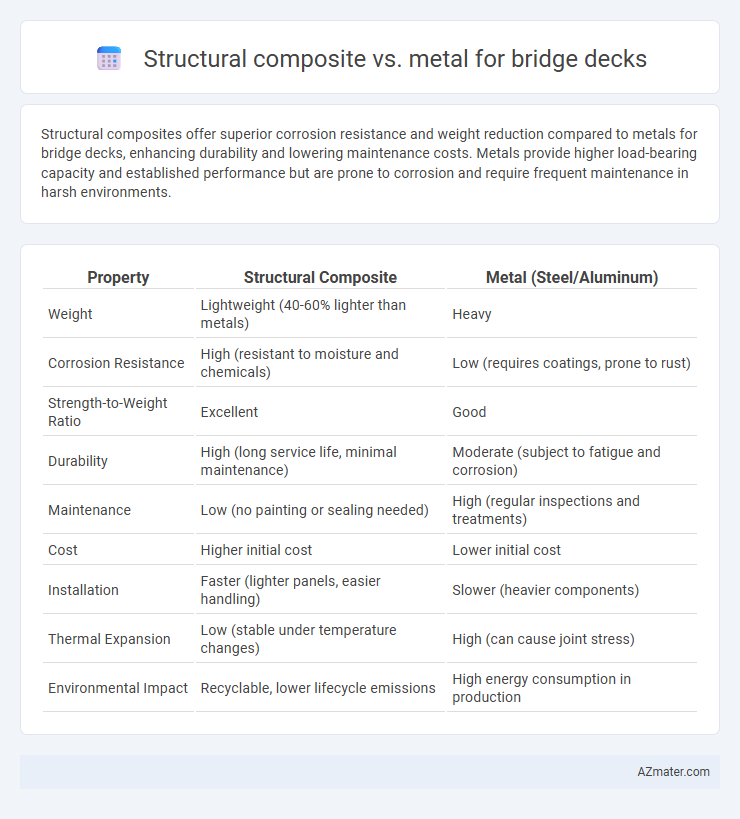Structural composites offer superior corrosion resistance and weight reduction compared to metals for bridge decks, enhancing durability and lowering maintenance costs. Metals provide higher load-bearing capacity and established performance but are prone to corrosion and require frequent maintenance in harsh environments.
Table of Comparison
| Property | Structural Composite | Metal (Steel/Aluminum) |
|---|---|---|
| Weight | Lightweight (40-60% lighter than metals) | Heavy |
| Corrosion Resistance | High (resistant to moisture and chemicals) | Low (requires coatings, prone to rust) |
| Strength-to-Weight Ratio | Excellent | Good |
| Durability | High (long service life, minimal maintenance) | Moderate (subject to fatigue and corrosion) |
| Maintenance | Low (no painting or sealing needed) | High (regular inspections and treatments) |
| Cost | Higher initial cost | Lower initial cost |
| Installation | Faster (lighter panels, easier handling) | Slower (heavier components) |
| Thermal Expansion | Low (stable under temperature changes) | High (can cause joint stress) |
| Environmental Impact | Recyclable, lower lifecycle emissions | High energy consumption in production |
Introduction to Bridge Deck Materials
Structural composite materials for bridge decks offer high strength-to-weight ratios, corrosion resistance, and reduced maintenance compared to traditional metals like steel and aluminum. Metal bridge decks provide excellent load-bearing capacity and proven durability but often require frequent inspections and protection against corrosion. Advances in composite technology enable longer service life and enhanced performance, making them increasingly popular for modern bridge constructions.
Overview of Structural Composites
Structural composites for bridge decks consist of materials such as fiber-reinforced polymers (FRP) that combine high-strength fibers with durable resin matrices, offering superior strength-to-weight ratios compared to traditional metals. These composites provide enhanced corrosion resistance, significantly reducing maintenance costs and extending the service life of bridge decks in harsh environments. The lightweight nature of structural composites also allows for easier installation and design flexibility, making them increasingly preferred over steel and aluminum in modern bridge construction.
Overview of Metal Deck Materials
Metal deck materials for bridge decks primarily include steel and aluminum alloys, known for their high strength-to-weight ratios and durability under heavy traffic loads. Steel decks offer excellent load-bearing capacity and ease of fabrication, while aluminum decks provide superior corrosion resistance and reduced maintenance costs. Both materials support long-span designs but require protective coatings to enhance longevity and prevent environmental degradation.
Comparative Weight and Load-Bearing Capacity
Structural composites for bridge decks offer significantly reduced weight compared to traditional metal materials, often weighing up to 50% less, which eases transportation and installation. Despite the lighter weight, composite materials provide comparable or superior load-bearing capacity due to high strength-to-weight ratios and enhanced fatigue resistance. Metals like steel deliver high load capacity but come with increased weight and susceptibility to corrosion, requiring more maintenance over time.
Durability and Corrosion Resistance
Structural composites offer superior durability and corrosion resistance compared to traditional metal bridge decks, significantly reducing maintenance costs and extending service life. Unlike steel or aluminum, composites resist moisture, chemicals, and environmental degradation, preventing rust and structural weakening. Their lightweight nature combined with high strength-to-weight ratios enhances long-term performance in corrosive or harsh conditions.
Installation and Construction Considerations
Structural composite bridge decks offer faster installation due to their lightweight nature, reducing the need for heavy lifting equipment and minimizing traffic disruptions. Metal decks, while durable, often require more extensive support and precise alignment during construction, increasing installation time and labor costs. Composite materials also provide corrosion resistance that can lower maintenance needs during the bridge's service life compared to traditional metal decks.
Maintenance and Lifespan Comparison
Structural composite bridge decks offer significantly lower maintenance requirements compared to traditional metal decks, as composites resist corrosion, fatigue, and chemical exposure more effectively. The lifespan of composite decks typically extends beyond 50 years, outlasting many metal counterparts that often require frequent inspections, coatings, and repairs due to rust and fatigue damage within 20 to 30 years. Reduced maintenance interventions on composite decks translate into lower life-cycle costs and enhanced long-term structural performance in bridge applications.
Cost Analysis: Initial and Lifecycle
Structural composite bridge decks typically exhibit higher initial costs compared to traditional metal decks due to advanced materials and manufacturing processes. Lifecycle cost analysis reveals composites offer reduced maintenance expenses, corrosion resistance, and extended service life, resulting in lower total ownership costs over time. Metal bridge decks demand frequent repairs and protective coatings, increasing long-term expenditure despite lower upfront investment.
Environmental Impact and Sustainability
Structural composites used in bridge decks significantly reduce environmental impact by offering lower carbon footprints and enhanced durability compared to traditional metals like steel or aluminum. These composites require less maintenance and resist corrosion, extending the service life of the bridge and minimizing resource consumption over time. Sustainable bridge design increasingly favors composites for their recyclability and reduced energy demand during production and installation.
Future Trends in Bridge Deck Engineering
Advancements in structural composites offer significant benefits over traditional metal bridge decks, including enhanced corrosion resistance, reduced weight, and longer service life, which are driving future trends in bridge deck engineering. Innovations such as fiber-reinforced polymer (FRP) composites enable easier installation and lower maintenance costs, making them increasingly preferred for sustainable infrastructure development. Ongoing research focuses on improving composite durability, recyclability, and cost efficiency to replace metals in critical bridge components effectively.

Infographic: Structural composite vs Metal for Bridge deck
 azmater.com
azmater.com